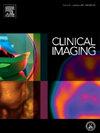Critical radiology results in thoracic imaging; categorization by urgency and clinical outcome
IF 1.5
4区 医学
Q3 RADIOLOGY, NUCLEAR MEDICINE & MEDICAL IMAGING
引用次数: 0
Abstract
Background
Timely communication of critical radiology results (CRRs) is vital for patient safety. However, data on the categorization and active follow-up of CRRs in thoracic imaging remain limited.
Purpose
The aim of our study was to investigate the prevalence of CRRs in thoracic radiology and to assess the extent to which clinical follow-up was performed.
Materials and methods
We retrospectively reviewed 741 CRRs from chest computed tomography (CT) and radiography between August 2018 and March 2021 at a tertiary care hospital. All CRRs were classified using the American College of Radiology three-tier urgency system and communicated through a structured electronic alert system. Active follow-up was defined as documentation of diagnostic or therapeutic response.
Results
Of 741 CRRs, 667 (90.0 %) were from CT and 74 (10.0 %) from radiography. The most common clinical settings were outpatient (43.3 %), followed by inpatients (35.8 %) and emergency department (20.9 %). CRRs were categorized as Category 1 (15.8 %), Category 2 (70.6 %), and Category 3 (7.3 %) based on the urgency. Pulmonary embolism and suspected malignancy were the most frequent actionable findings. Active clinical responses were documented in 733 cases (98.9 %), including all Category 1 CRRs. However, 1.1 % of cases, mostly Category 3 or incidental findings, lacked documented follow-up, particularly in outpatient or cross-specialty scenarios.
Conclusion
A structured alert system for CRRs enabled prompt communication and follow-up adherence. However, non-urgent but actionable findings are still at risk of being lost to follow-up. Enhanced and integrated tracking systems are essential to ensure consistent and comprehensive management of all actionable radiologic findings.
胸部影像学的关键放射学结果;按急症和临床结果分类
关键放射学结果(CRRs)的及时沟通对患者安全至关重要。然而,关于crr在胸部影像学中的分类和积极随访的数据仍然有限。目的本研究的目的是调查crr在胸部放射学中的患病率,并评估临床随访的程度。材料和方法回顾性分析了一家三级医院2018年8月至2021年3月期间胸部CT和x线摄影的741例crr。使用美国放射学会三级紧急系统对所有crr进行分类,并通过结构化电子警报系统进行沟通。积极随访被定义为诊断或治疗反应的记录。结果741例crr中,CT检查667例(90.0%),x线检查74例(10.0%)。最常见的临床环境是门诊(43.3%),其次是住院(35.8%)和急诊(20.9%)。crr按急迫性分为1类(15.8%)、2类(70.6%)和3类(7.3%)。肺栓塞和疑似恶性肿瘤是最常见的可采取行动的发现。733例(98.9%)病例记录了积极的临床反应,包括所有1类crr。然而,1.1%的病例,主要是3类或偶然发现,缺乏记录的随访,特别是在门诊或跨专业的情况下。结论有组织的CRRs预警系统可使CRRs及时沟通和随访依从。然而,非紧急但可采取行动的调查结果仍有可能失去后续行动。加强和综合跟踪系统对于确保所有可操作的放射检查结果的一致和全面管理至关重要。
本文章由计算机程序翻译,如有差异,请以英文原文为准。
求助全文
约1分钟内获得全文
求助全文
来源期刊

Clinical Imaging
医学-核医学
CiteScore
4.60
自引率
0.00%
发文量
265
审稿时长
35 days
期刊介绍:
The mission of Clinical Imaging is to publish, in a timely manner, the very best radiology research from the United States and around the world with special attention to the impact of medical imaging on patient care. The journal''s publications cover all imaging modalities, radiology issues related to patients, policy and practice improvements, and clinically-oriented imaging physics and informatics. The journal is a valuable resource for practicing radiologists, radiologists-in-training and other clinicians with an interest in imaging. Papers are carefully peer-reviewed and selected by our experienced subject editors who are leading experts spanning the range of imaging sub-specialties, which include:
-Body Imaging-
Breast Imaging-
Cardiothoracic Imaging-
Imaging Physics and Informatics-
Molecular Imaging and Nuclear Medicine-
Musculoskeletal and Emergency Imaging-
Neuroradiology-
Practice, Policy & Education-
Pediatric Imaging-
Vascular and Interventional Radiology
 求助内容:
求助内容: 应助结果提醒方式:
应助结果提醒方式:


